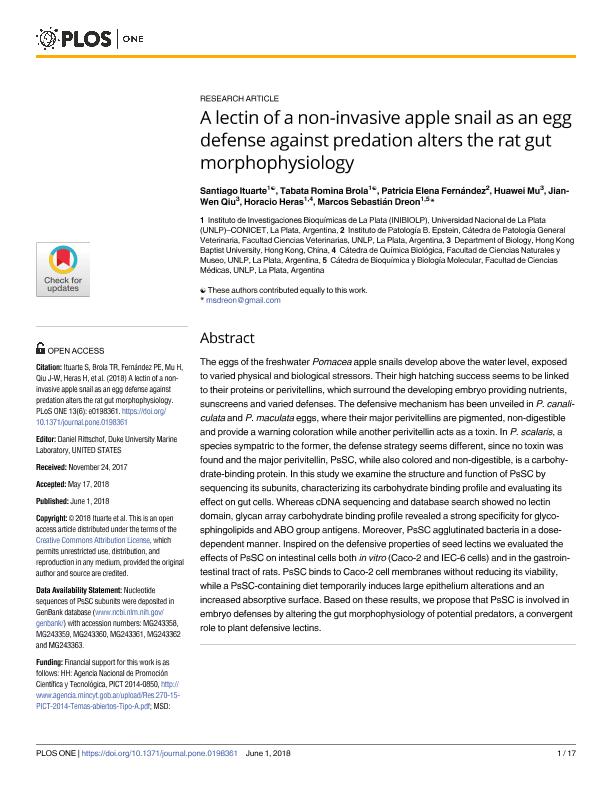Mostrar el registro sencillo del ítem
dc.contributor.author
Ituarte, Santiago

dc.contributor.author
Brola, Tabata Romina

dc.contributor.author
Fernández, Patricia Elena

dc.contributor.author
Mu, Huawei
dc.contributor.author
Qiu, Jian Wen

dc.contributor.author
Heras, Horacio

dc.contributor.author
Dreon, Marcos Sebastian

dc.date.available
2020-02-17T22:50:57Z
dc.date.issued
2018-06
dc.identifier.citation
Ituarte, Santiago; Brola, Tabata Romina; Fernández, Patricia Elena; Mu, Huawei; Qiu, Jian Wen; et al.; A lectin of a non-invasive apple snail as an egg defense against predation alters the rat gut morphophysiology; Public Library of Science; Plos One; 13; 6; 6-2018; 1-17; e0198361
dc.identifier.issn
1932-6203
dc.identifier.uri
http://hdl.handle.net/11336/97864
dc.description.abstract
The eggs of the freshwater Pomacea apple snails develop above the water level, exposed to varied physical and biological stressors. Their high hatching success seems to be linked to their proteins or perivitellins, which surround the developing embryo providing nutrients, sunscreens and varied defenses. The defensive mechanism has been unveiled in P. canaliculata and P. maculata eggs, where their major perivitellins are pigmented, non-digestible and provide a warning coloration while another perivitellin acts as a toxin. In P. scalaris, a species sympatric to the former, the defense strategy seems different, since no toxin was found and the major perivitellin, PsSC, while also colored and non-digestible, is a carbohydrate-binding protein. In this study we examine the structure and function of PsSC by sequencing its subunits, characterizing its carbohydrate binding profile and evaluating its effect on gut cells. Whereas cDNA sequencing and database search showed no lectin domain, glycan array carbohydrate binding profile revealed a strong specificity for glycosphingolipids and ABO group antigens. Moreover, PsSC agglutinated bacteria in a dose-dependent manner. Inspired on the defensive properties of seed lectins we evaluated the effects of PsSC on intestinal cells both in vitro (Caco-2 and IEC-6 cells) and in the gastrointestinal tract of rats. PsSC binds to Caco-2 cell membranes without reducing its viability, while a PsSC-containing diet temporarily induces large epithelium alterations and an increased absorptive surface. Based on these results, we propose that PsSC is involved in embryo defenses by altering the gut morphophysiology of potential predators, a convergent role to plant defensive lectins.
dc.format
application/pdf
dc.language.iso
eng
dc.publisher
Public Library of Science

dc.rights
info:eu-repo/semantics/openAccess
dc.rights.uri
https://creativecommons.org/licenses/by-nc-sa/2.5/ar/
dc.subject
egg
dc.subject.classification
Bioquímica y Biología Molecular

dc.subject.classification
Ciencias Biológicas

dc.subject.classification
CIENCIAS NATURALES Y EXACTAS

dc.title
A lectin of a non-invasive apple snail as an egg defense against predation alters the rat gut morphophysiology
dc.type
info:eu-repo/semantics/article
dc.type
info:ar-repo/semantics/artículo
dc.type
info:eu-repo/semantics/publishedVersion
dc.date.updated
2019-10-18T19:02:37Z
dc.journal.volume
13
dc.journal.number
6
dc.journal.pagination
1-17; e0198361
dc.journal.pais
Estados Unidos

dc.journal.ciudad
San Francisco
dc.description.fil
Fil: Ituarte, Santiago. Consejo Nacional de Investigaciones Científicas y Técnicas. Centro Científico Tecnológico Conicet - La Plata. Instituto de Investigaciones Bioquímicas de La Plata "Prof. Dr. Rodolfo R. Brenner". Universidad Nacional de la Plata. Facultad de Ciencias Médicas. Instituto de Investigaciones Bioquímicas de La Plata "Prof. Dr. Rodolfo R. Brenner"; Argentina
dc.description.fil
Fil: Brola, Tabata Romina. Consejo Nacional de Investigaciones Científicas y Técnicas. Centro Científico Tecnológico Conicet - La Plata. Instituto de Investigaciones Bioquímicas de La Plata "Prof. Dr. Rodolfo R. Brenner". Universidad Nacional de la Plata. Facultad de Ciencias Médicas. Instituto de Investigaciones Bioquímicas de La Plata "Prof. Dr. Rodolfo R. Brenner"; Argentina
dc.description.fil
Fil: Fernández, Patricia Elena. Universidad Nacional de la Plata. Facultad de Ciencias Veterinarias. Departamento de Patología. Laboratorio de Patología Especial Veterinaria "Dr. Bernardo Epstein"; Argentina
dc.description.fil
Fil: Mu, Huawei. Hong Kong Baptist University; Hong Kong
dc.description.fil
Fil: Qiu, Jian Wen. Hong Kong Baptist University; Hong Kong
dc.description.fil
Fil: Heras, Horacio. Consejo Nacional de Investigaciones Científicas y Técnicas. Centro Científico Tecnológico Conicet - La Plata. Instituto de Investigaciones Bioquímicas de La Plata "Prof. Dr. Rodolfo R. Brenner". Universidad Nacional de la Plata. Facultad de Ciencias Médicas. Instituto de Investigaciones Bioquímicas de La Plata "Prof. Dr. Rodolfo R. Brenner"; Argentina
dc.description.fil
Fil: Dreon, Marcos Sebastian. Consejo Nacional de Investigaciones Científicas y Técnicas. Centro Científico Tecnológico Conicet - La Plata. Instituto de Investigaciones Bioquímicas de La Plata "Prof. Dr. Rodolfo R. Brenner". Universidad Nacional de la Plata. Facultad de Ciencias Médicas. Instituto de Investigaciones Bioquímicas de La Plata "Prof. Dr. Rodolfo R. Brenner"; Argentina
dc.journal.title
Plos One

dc.relation.alternativeid
info:eu-repo/semantics/altIdentifier/doi/http://dx.doi.org/10.1371/journal.pone.0198361
dc.relation.alternativeid
info:eu-repo/semantics/altIdentifier/url/https://journals.plos.org/plosone/article?id=10.1371/journal.pone.0198361
Archivos asociados
